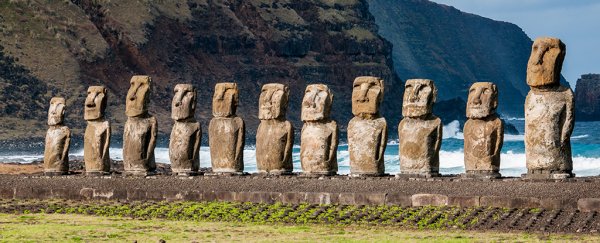Carving giant, monolithic statues under the hot Polynesian Sun is thirsty work. So without freshwater rivers and springs to sustain them, how did thousands of the traditional Rapa Nui people of Easter Island survive?
We might finally have an answer to this historic mystery, and it's one that reconciles early European accounts of the Rapa Nui drinking what appeared to be seawater – but almost certainly wasn't.
A new study shows how coastal groundwater discharge around the island could have been collected by the Rapa Nui people and used as freshwater, because its salt content would have been low enough for humans to drink.
So Europeans arriving in the 18th century got it wrong about the locals drinking seawater (kind of). That wasn't seawater, but fresh rainwater running through the porous volcanic soils that make up Easter Island, where it then mixes with seawater.
"Water beneath the ground flows downhill and ultimately exits the ground directly at the point at which the porous subterranean rock meets the ocean," says the lead researcher behind the study, anthropologist Carl Lipo from Binghamton University in New York.
"When tides are low, this results in the flow of freshwater directly into the sea. Humans can thus take advantage of these sources of freshwater by capturing the water at these points."
Lipo and his team measured this brackish water at multiple points around the island, determining that its salinity was low enough to drink safely (9,000 parts-per-million is considered to be the limit).
This water might have been safe, but it would still have been salty. As it happens, this fits with previous research suggesting the Easter Island diet was very low in salt, maybe because islanders were already getting plenty of salt in their drinking water.
The brackish water is suggested to have been captured in rocky basins that have since been largely lost to time, though some evidence of the wells still remains.
In support of the hypothesis, the team also investigated the scant alternative sources of freshwater on the island, including two lakes (which are difficult to access), and one spring, along with small cisterns called taheta that would've been used to collect rainwater.
Add in the low rainfall of the island (just 1,240 mm or 49 inches per year), and together these freshwater sources wouldn't have been enough to support a population as large as the Rapa Nui, the researchers suggest, especially in times of drought.
What's more, this idea could explain the mystery of why the famous Easter Island statues are mostly found clustered around the coasts – those locations may have signified where people could get a drink.
"Now that we know more about the location of freshwater… the location of these monuments and other features makes tremendous sense," says Lipo. "They are positioned where freshwater is immediately available."
The next step is to work out how this water source might have contributed to the construction of the gigantic Moai statues – a remarkable feat of engineering that Lipo already has quite a few ideas about.
The team has previously published research on how the Easter Island inhabitants might have sustained themselves by farming the land and fishing the nearby seas, even in the challenging conditions of the remote, isolated location.
And it could even teach us more about surviving in difficult conditions in the modern day – by borrowing a few techniques from the inventive people of Rapa Nui.
"This information ultimately sheds light on the conditions that drove and enabled these communities to work together to achieve their feats of engineering," says Lipo.
"By gaining knowledge about community scale behaviour, we can gain insights into the general conditions necessary for group-level cooperation – whether in the past or in contemporary society."
The research has been published in the Hydrogeology Journal.
